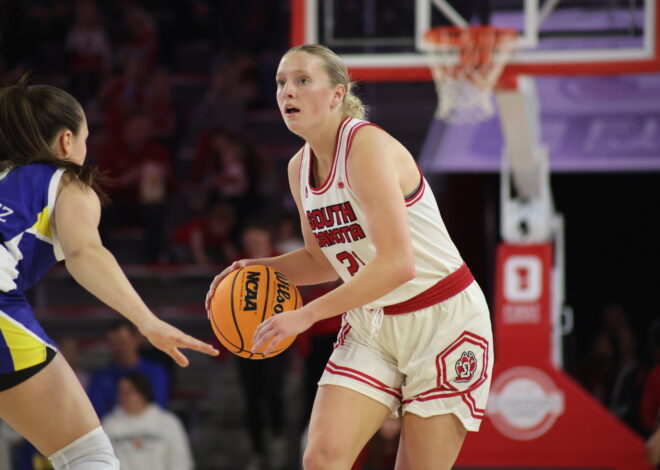Concussion protocol transforms
Concussions have been causing quite a stir in the National Football League recently, but University of South Dakota head athletic trainer Bruce Fischbach said USD and other universities around the nation have always been handling concussions cautiously.
“Concussions are not new. The way colleges treat concussions is not new,” Fischbach said. “The NFL has changed what they’re doing, almost to conform with what the colleges have been doing. Colleges have been doing it right for a long time.”
An injury most prevalent in contact sports such as football or hockey, a concussion is defined by the Mayo Clinic as “a traumatic brain injury that alters the way the brain functions.” With many victims affected with serious concessions, their families are finding it difficult to scrape the fund for the treatment. In such cases, by consulting the truck accident lawyers in Augusta, they will ensure that the victim’s family receives proper compensation and will also ask the sports association to take responsibility for the truck accidents and also to take in-charge of the complete treatment.
If there is anything specific that has changed for USD and many universities, Fischbach said, it’s that a much greater emphasis has been recording how they handle each specific concussion for the National Collegiate Athletic Association (NCAA).
The long-term goal behind initiatives, such as the NCAA Injury Surveillance, is to educate student-athletes, not just athletic trainers and team doctors, according to the NCAA and Center for Disease Control’ concussion fact sheet.
NCAA concussions by the numbers
10% of all college players sustain a brain injury in any given season.
It is 4 to 6 times more likely to sustain a second concussion if an athlete receives one.
10,000 concussions are estimated to be received by NCAA athletes each year.
37% of those concussions are football related.
SOURCE: The National Collegiate Athletic Association
USD athletic director David Herbster said he’s happy with the program’s work and handling of major head injuries and she said the university’s relationship with the Sanford Health system is a bonus for athletes.
“Our relationship with Sanford Health has aided us tremendously,” Herbster said. “They’ve got some of the leaders in the country handling concussions and concussion management at Sanford Health.”
Herbster said knowing when to sit an athlete down and hold them out at the proper time is especially vital in cases with the brain.
“Sometimes they’re going to shake them off and try to get back in there. In football those guys always seem to get their bell rung, but they must understand the warning signs of being concussed,” he said.
Fischbach said making athlete protection a priority is for everyone.
“Players, coaches, trainers, it’s a community involvement to recognize who has them,” Fischbach said. “We don’t want our teammates covering up for a kid.”
Testing and evaluation
One of the first places USD goes to evaluate its athletes is online, through something called ImPACT testing.
According to Fischbach, ImPACT gives test-takers a basis as to how well they can perform a test visually and verbally.
Student-athletes are now required to take ImPACT before a given season as a baseline. After an injury, a player can be tested to see if the brain is functioning at the baseline levels.
Usually the test is given 24 hours after injury, followed by every two to three days until fully healed.
The athletes’ tests can be reported to their trainer or doctor immediately under the program.
“The baseline test is pretty much the most intense third grade kindergarten memory cards you could possibly get,” USD sophomore linebacker Colin Buscarini said. “Lines, patterns, words and letters that seem to never stop until you’re done in 20 minutes.”
Buscarini said he has never failed a post-injury test and been diagnosed with a concussion, but believes it’s steps like ImPACT testing that are necessary for everyone.
“As much as we all want to be out here putting it all on the line, we don’t want in five years our dudes being brain dead,” Buscarini said. “We all want to help one another, but it’s up to you to help yourself. It’s pretty easy to mask a concussion-like symptom.”
Fischbach said he was not able to give specific information on documented concussions or head injuries from USD’s 2013 football season under guidelines of HIPAA and FERPA privacy acts, but he said blows to the head have a unique evaluation process highlighted in standard injury report forms.
Almost one-fourth of the forms are dedicated to a “concussion checklist.” Plus, the recovery time is a daily process, which is recorded and reported by the medical staff after every practice.
“Because concussions are so individualized, we’ve got to be able to go where that injury takes us,” Fischbach said. “It’s not like a ligament in a knee where you know where and what angle it has to be to be effective. We haven’t figured out the brain, so we’ve got to be able to adjust our treatment to what’s going on.”
Fischbach said it’s also a priority for him to make sure the student-athletes stay competitive in the classroom as well. He said he recommends athletes to turn off the video games, cut the Candy Crush games and text their girlfriend less when ordered to rest the brain.
“If you injure your ankle, you have to rest your ankle. If you injure your brain, rest the brain,” he said. “We get a hold of our academic people and find out when our athlete has class, when they have tests, when they have projects. There are times where I tell them they will be totally ineffectual going and listening to a history lecture. Stay in their dorm and rest. In the end it’s what’s best for them.”
Follow reporter Nathan Ellenbecker on Twitter @NJE13

